An Australian & the shortest man in the British Army?
- Home
- World War I Articles
- An Australian & the shortest man in the British Army?
The following pension card for Frank Clifford Wittman shows an unusual address of Mildura, a town in the state of Victoria, and on the Murray River. This was the site of a major re-settlement area, known as Red Cliffs, established for returning war veterans.

Frank’s medal index card confirmed his rank of acting corporal, and the issue of the British War and Victory Medals.

Frank Clifford Wittman was found to have been a unique name, making his identification straightforward, and his story best presented in chronological order.
He was born on 3 April1889 in the town of Warragul, some sixty miles from Melbourne, being the son of George Wittman and Rebecca Isaacs, who had married the previous year.
The 1913 electoral roll records Frank as an apprentice, living in the Melbourne suburb of Brighton, but does not reveal his trade. By 1915, the electoral roll shows he had by now qualified as a chemist, and was living in East Melbourne.
He enlisted in the Australian Imperial Force, but wasn’t allowed to go on active service overseas, for reasons that will later become evident. He obtained a discharge so that he could travel to England and join the R.A.M.C. (Royal Army Medical Corps). Frank took a second class passage from Sydney on board the SS Tainui arriving in Southampton on the 14 April 1917.

Above: The SS Tainui, belonging to the Shaw Savill & Albion Co Ltd.
His service record has survived in series WO 363, the burnt series, and shows distinct signs of charring. His attestation form, part of which is reproduced below, shows he enlisted in Blackpool on 9 May 1917, his occupation given as a chemist. He declared previous service with the Australian Army Medical Corps, from which he was discharged on 27November 1916.

Above: Frank’s attestation paper
It became clear why the Australian Imperial Force (A.I.F.) were reluctant to send Frank into active service, his height being just over 4 ft 4 in. He is widely acknowledged as the smallest man ever to have enlisted in the A.I.F.
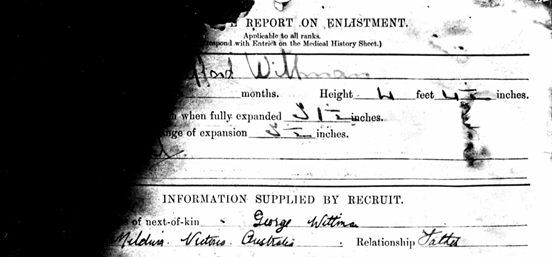
Above: the Medical Report on enlistment
Frank would still have failed by some six inches to meet the minimum requirements to join even a British Bantam Battalion, but the R.A.M.C. were clearly more accepting of his skills and determination.

Above: this photograph appeared some years ago on greatwarforum.org, taken from the book ‘Just Soldiers, Stories of ordinary Australians doing extraordinary things in time of war’ by Darryl Kelly, and published by the Anzac Day Commemoration Committee in 2004. There are no prizes for identifying Frank.
His active service form shows he served in Mesopotamia from July 1918 onwards. He was assigned to the sanitary section, whose responsibilities included the provision of clean water, inspection of billets, and management of washing and de-lousing facilities.
Although he wished to remain in the forces, the decision was made in April 1919 for his return to the UK for subsequent repatriation to Australia. Frank returned to England on 19 June 1919, on the Indian Expeditionary Force Hospital Ship H.M.H.S. Ellora, and attended Shorncliffe hospital prior to repatriation. His service record indicates he was discharged on 10 January 1920 as no longer fit for war service: this would have followed his arrival in Australia.
Frank has a small file in the Australian Archives, dated 1920, which largely contains information supplied by the RAMC regarding his repatriation. He had left England on 29 November 1919 on board the S.S. Solfels, a ship requisitioned from Germany as part of reparations, and renamed ‘Bowes Castle’ in 1920.
His first pension award, following his discharge in Australia on 10 January 1920, relates to his incapacitation from both rheumatism and a hernia.
There was a great deal of official correspondence between the UK and Australia following his repatriation, the system evidently couldn’t cope with the fact that he had been an Australian citizen serving in the British Army.
There are several copies of letters in his U.K. service file trying to trace his whereabouts after arrival in Australia, so that his medical records could be forwarded. The following is an example of a correspondence document found in Frank’s file in the National Archives of Australia. This form records that Frank had eventually reported to the Australian authorities in Melbourne after his arrival in Australia.

It should be noted that the first document in his Australian file is a header from an attestation form, that makes the distinct point that the papers do not refer to service in the A.I.F.

It is possible that his original A.I.F. attestation form does still exist, as a search in the indexes of the Australian Archives (naa.gov.au) shows a file, not yet digitised, and from 1915, showing his place of birth as Warragul, and his occupation of chemist.
Post War Army Correspondence
Frank made various attempts to have his original passage from Australia refunded after the war. The following example is useful as it gives the dates of both his entering and leaving the AIF.
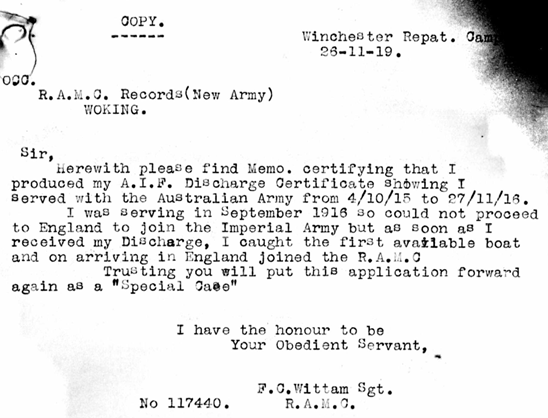
The R.A.M.C. also officially supported his application to the war office, but the usual red tape prevailed, and the prize for official gobbledygook goes to the writer of this particular response to a priorplea by the R.A.M.C. on Frank’s behalf.
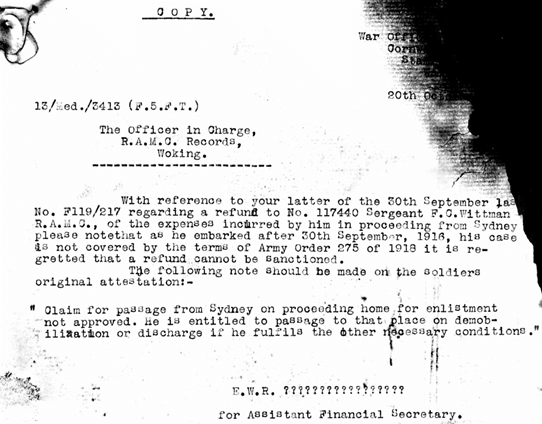
The correspondence finally fizzled out, but the last piece of officialdom was to reject Frank’s application for a Silver War Badge, as his discharge date came just a little too late.
Australian Life Post War
The 1919 Electoral Roll for Corio, a suburb of the town of Geelong in Victoria shows Frank was still associated with the army, and staying at Osborne House. Note that the actual year recorded on electoral rolls is not entirely reliable, and this probably records a temporary address in 1920.
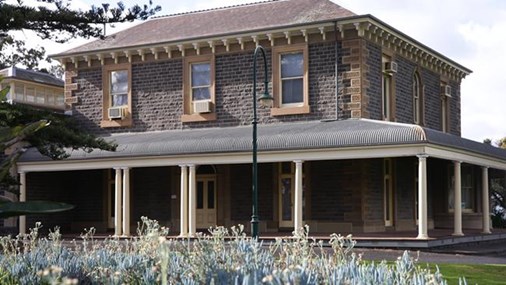
Above: Osborne House was named after Queen Victoria’s summer residence on the Isle of Wight, and was used as military hospital in the Great War, and immediately afterwards.
This historic house, built in 1858, has recently had to close due to serious mould issues; this wouldn’t have happened on Frank’s watch.
Frank had evidently maintained his pharmaceutical registration, the following entry being from the Victoria Gazette of January 1919, which records his address as Mildura, as found on his pension card.


Battle to Farm Land Records
This series of records, found on ancestry.com., records the allocation of land for returning servicemen.
After his return to Australia Frank displayed an interest in fruit growing, his father’s occupation, and applied for a land grant in Mildura, in an area known as Red Cliffs, where returning soldiers were explicitly encouraged to settle.
The following is his statement of intent to grow fruit on allocated land, and confirmation that he had sufficient capital.
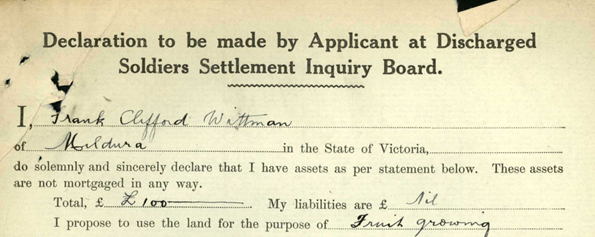
He applied for a qualification certificate on the basis of experience gained from working with his father, and a desire to give up his occupation of chemist for an open air life.

He gained the following certificate, necessary to apply for land, on 8March 1920.

The subsequent application for land at Red Cliffs was approved the same month. A subsequent application for an allotment lease was granted the following year. Favourable terms as a returning veteran meant that payment was suspended for three years.
Having successfully negotiated this veritable minefield of officialdom, it isn’t known how long Frank spent in fruit farming, although he may have been restricted to the picking of low hanging fruit.
The 1927 Electoral Roll for Mildura, listing all Wittmans alphabetically, records him as a chemist. Note that not all the Wittmans are necessarily related to Frank.
His father George was a fruit grower at 65 Balaclava Road, while Frank was living with his mother, at 27 Labassa Grove, she using her preferred name of Ruby rather than Rebecca. His sister Constance was also living at Labassa Grove.

The 1928 Electoral Roll showed the family all at one address, this time at no 73 Balaclava Road.

Proof that the date of the published electoral rolls is unreliable is provided by the fact that Constance Irma Wittman had married Thomas Longton Tyrer in 1927.
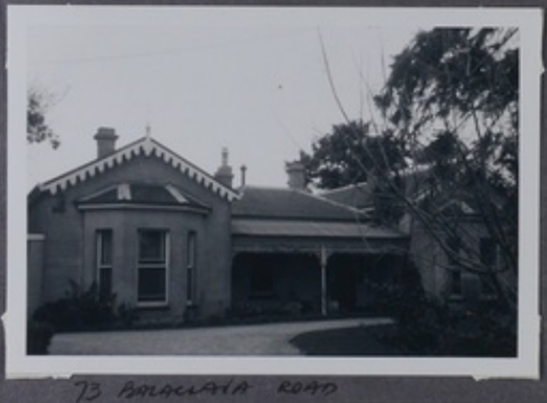
Above: The house is pictured in a photo album from victoriancollections.net.au.
His mother’s death was registered in the Caulfield district in 1930, aged 64, while his father George died in 1931, aged 71, his death being registered in East Melbourne.
In 1931 Frank was still registered as a chemist, but back at 65 Balaclava Road, while by 1938 he had moved to 22 Wattletree Road, in the Melbourne inner suburb of Armadale.
Melbourne Legacy
The Melbourne Legacy is an organisation which supports serving Australians and veterans, and is dedicated to caring for families of Australian veterans who have lost their lives or health serving their country. Their volunteers are known as legatees, and Frank Clifford Wittman was a such a man.
The following photographs, all of which feature Frank, appear on victoriancollections.net.au and are from the Port Melbourne Historical & Preservation Society.

Above: from 1938, the photograph shows General Sir Henry George Chavel, a Gallipoli veteran, and Lady Chavel, passing the Guard of Honour at a new branch in Port Melbourne.

Above: Legatees are pictured in the Grampians National Park in 1940, Frank is at the centre of the front row.

Above: Frank is shown with other Legatees in 1940 at a conference in Launceton, Victoria, second left on the front row.
The 1943 Electoral Roll shows Frank was still living in Armadale, with a minor change in house number. By 1949 he had moved to Prahran, another suburb of Victoria. Not a man to stay in one place, he was back in Caulfield by 1954.By 1963 he had retired, and resided at 102 North Road, Brighton from then until at least 1968.
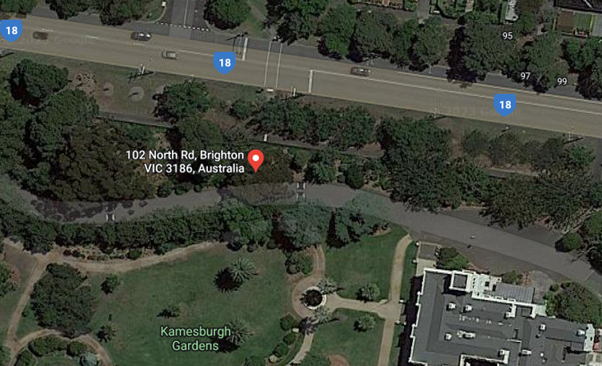
Above: This address is no longer occupied by an identifiable house, but would evidently have been located in a garden area. The large building to the right of the picture is a care home dating from 2011.
Brighton is one of Melbourne’s most exclusive suburbs, and being by the seaside is perhaps Victoria’s answer to Worthing where retirement is concerned, having three miles of coastline.
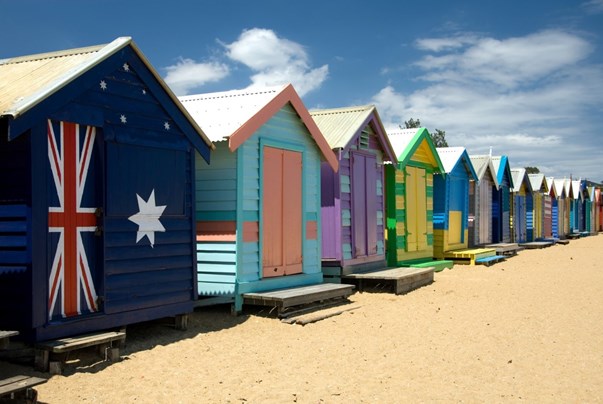
Above: These beach huts are in Brighton, Melbourne, not Brighton, Sussex!
Death and Obituary
Frank remained single throughout his life, and died on 15 August 1980. His ashes were scattered at Springvale Botanical Cemetery, in Greater Dandenong City, a suburb of Melbourne.
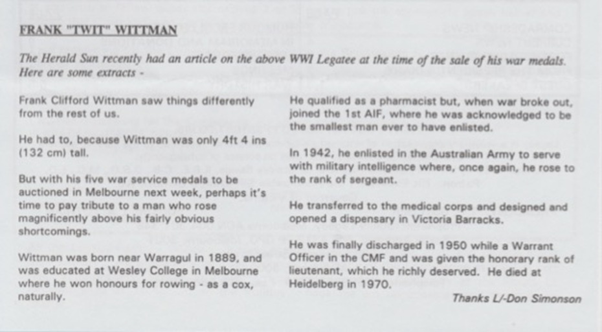
Above: Frank’s obituary is taken from the Herald Sun, and appears in victoriancollections.net.au.
A document in the Australian archives, dated 1947-50, and unfortunately not yet digitised, shows an application for a commission for V14711, Warrant Officer Class 1, Frank Clifford Wittman. The fact that he wasn’t discharged until 1950, clearly matched his wish to have remained in the forces after the Great War had ended, and his commission reflects the great respect in which he was held.
Summary
This card proved to belong to an extraordinary Australian. Just four feet four inches in height, and a pharmacist by trade, Frank Clifford Wittman enlisted in the A.I.F., but had to obtain a discharge and pay his own way to England to be permitted to serve in a war zone. After serving in Mesopotamia he was discharged and returned to his native Victoria, to try his hand at fruit farming. He returned to his job as a pharmacist, but saw home service in WW2 firstly in military intelligence, and later running an army pharmacy. He reached the rank of Warrant Officer and was made an Honorary Lieutenant.
Article contributed by Dr. Alan Hawkins





